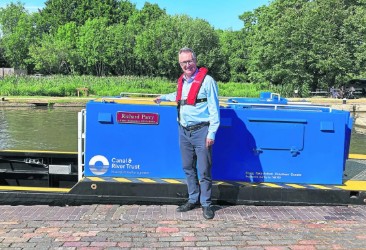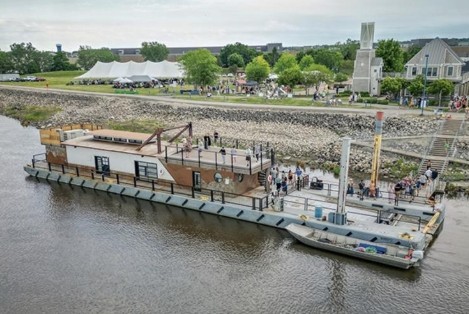Boat naming honour for outgoing CRT chief executive
 How cool to have a boat named after you. Can there be a higher accolade? I always thought a street being named after you, or a library perhaps, would be incredible, but a boat has far more cache! This was the surprise that awaited Richard Parry, the outgoing chief executive of the Canal & River Trust. Volunteers and colleagues at the charity’s base on the Grand Union’s Hatton lock flight in the UK have named a new workboat in his honour.
How cool to have a boat named after you. Can there be a higher accolade? I always thought a street being named after you, or a library perhaps, would be incredible, but a boat has far more cache! This was the surprise that awaited Richard Parry, the outgoing chief executive of the Canal & River Trust. Volunteers and colleagues at the charity’s base on the Grand Union’s Hatton lock flight in the UK have named a new workboat in his honour.
The 30ft work boat and hopper will be used for operational maintenance including Continue reading “What caught my eye: October 2025”
 Dear colleague
Dear colleague
 You don’t need me to remind you of the safety concerns and issues surrounding lithium-ion battery technology. My views are well known! But this is the first instance I am aware of a narrowboat on the UK canal network exploding as a result of this battery technology. Reports suggest that debris was thrown 40ft across the canal and witnesses said the explosion was very loud and shook their boats. Fortunately, there were no injuries. This is yet another wake up call, but sadly, I suspect we will never know what caused the batteries to blow given the total destruction of the boat.
You don’t need me to remind you of the safety concerns and issues surrounding lithium-ion battery technology. My views are well known! But this is the first instance I am aware of a narrowboat on the UK canal network exploding as a result of this battery technology. Reports suggest that debris was thrown 40ft across the canal and witnesses said the explosion was very loud and shook their boats. Fortunately, there were no injuries. This is yet another wake up call, but sadly, I suspect we will never know what caused the batteries to blow given the total destruction of the boat. 
 This is the first of three stories I have chosen to highlight this month, all of which originate from Norway.
This is the first of three stories I have chosen to highlight this month, all of which originate from Norway. In recent years, IIMS has published a number of articles about the growing problem of what to do with end-of-life boats and the challenges of recycling them. It remains a thorny subject and will be discussed in this edition of what caught my eye: February 2025.
In recent years, IIMS has published a number of articles about the growing problem of what to do with end-of-life boats and the challenges of recycling them. It remains a thorny subject and will be discussed in this edition of what caught my eye: February 2025. When I read this story in December 2024 despite the report coming out in October, it did not shock me, but it certainly saddened me. I guess we all know the inherent dangers that fishers the world over face. So, I read that a global safety charity is calling for urgent change and investment after its latest report named fishing as the world’s most dangerous occupation.
When I read this story in December 2024 despite the report coming out in October, it did not shock me, but it certainly saddened me. I guess we all know the inherent dangers that fishers the world over face. So, I read that a global safety charity is calling for urgent change and investment after its latest report named fishing as the world’s most dangerous occupation. The first artwork on water by Alex Chinneck, the sculpture celebrates Sheffield’s historic waterways and industrial heritage. It takes the form of a full-size canal boat, whose body behaves in an extraordinary way, performing a six metre-high, gravity-defying, loop-the-loop.
The first artwork on water by Alex Chinneck, the sculpture celebrates Sheffield’s historic waterways and industrial heritage. It takes the form of a full-size canal boat, whose body behaves in an extraordinary way, performing a six metre-high, gravity-defying, loop-the-loop. It seems we have gone full circle. Cargo ships powered by sail were lost to us a century or more ago, and to the current generation such vessels are regarded as outmoded transportation from a bygone era. But now they are back, more sophisticated and sustainable than ever. Recently I read about the Anemos, which has claimed the title of the world’s largest sailing cargo ship as she made her inaugural voyage from Concarneau, South Brittany, France.
It seems we have gone full circle. Cargo ships powered by sail were lost to us a century or more ago, and to the current generation such vessels are regarded as outmoded transportation from a bygone era. But now they are back, more sophisticated and sustainable than ever. Recently I read about the Anemos, which has claimed the title of the world’s largest sailing cargo ship as she made her inaugural voyage from Concarneau, South Brittany, France. 
 The three Palmerston forts in The Solent off the UK’s south coast are iconic structures known to many, dating back to 1859 when they were built to counter the threat of invasion by the French. For me they are a familiar sight, but I have never had the opportunity to land on these extraordinary structures – only admire them from afar with extreme curiosity.
The three Palmerston forts in The Solent off the UK’s south coast are iconic structures known to many, dating back to 1859 when they were built to counter the threat of invasion by the French. For me they are a familiar sight, but I have never had the opportunity to land on these extraordinary structures – only admire them from afar with extreme curiosity.